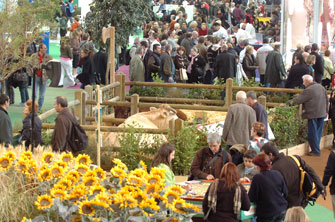The Quête for
Aiguillette

You’ll find everything from four-ton bulls to duck suprême at the Salon de l’Agriculture.
I feel about the Salon de l’Agriculture, France’s annual agricultural fair, the same way I feel about Bangkok: it’s noisy, crowded, visually unappealing and in a lot of places malodorous, but I still love it, mainly because there’s so much good, cheap food to be had. It’s held every February at the Porte de Versailles exhibition complex and I never miss it. My devotion has nothing to do with the presumably tranquilized four-ton bulls and submarine-sized hogs on display. In fact I give the livestock pavilions a miss entirely and head straight for the “Pôle Produits.”
Have you ever dreamed of finding all of France’s finest terroir foods under one roof? Well wake up salivating, because regional specialties are what the products pavilion is all about: cider, fruits and pastry from Brittany; ham, beer and sweets from Basque country; wine, wine and wine from Burgundy; foie gras from just about everywhere, cheese from literally everywhere; and even spices from the Antilles. And, since this is a promotional event, the prices, with a few exceptions, range from cut-rate to reasonable. I always take a big shopping bag and stock up on pâté, foie gras, various other kinds of charcuterie (I have a weakness for smoked pork), any cheese that catches my eye – or nose – and any other products that I can’t easily find in Paris.
Last year, I went to the Salon de l’Agriculture on a specific quest for something my wife and I crave but can rarely enjoy: aiguillette de canard, or duck suprême, that little strip of filet from the underside of the breast that’s a separate, little-used (by the duck) and therefore spectacularly tender muscle. In southwest France, for example around Sarlat, you can get aiguillette in almost any “local specialties” bistro, but in Paris it’s dauntingly difficult to find, especially raw, which is what I wanted. A few restaurants list it on the menu, but it usually turns out to be a regular magret filet cut into strips. It can be good, but it’s not the real thing. Hint: if there’s skin on it, that ain’t no aiguillette.
At the time of last year’s Salon de l’Agriculture, I had never found raw aiguillette in Paris (see note below), so you can imagine my satisfaction when, after washing down a hot sausage and onion sandwich with a glass of Alsatian ambrée beer, getting a great two-for-one deal on foie gras from Les Landes, buying a pack of tongue-blistering but tasty paprika from Martinique, trying a kind of cheese from the Lot that had somehow escaped my attention until then, and giving up on my plan to slurp down a few raw oysters because there was only one oyster stand and they were asking €15 a dozen (twice what I would expect to pay at a trade fair), I finally happened on a vendor from the Dordogne who had real honest-to-dieu aiguillette de canard, in vacuum packs of about 16 filets for under €10 each.
I asked for two packs and mentioned to the man behind the counter how hard it is to find real aiguillette, which I identified by the thin white tendon running the length of each piece. He congratulated me on my connoisseurship, which I didn’t take too seriously since I already had my wallet out, and told me to sauté them tendon side up first to avoid curling. Then he threw in a can of gésiers confits as a bonus, which I greatly appreciated. As the expression goes, the way to a man’s heart is through a duck’s gizzard.
My aiguillette supply was enough for four dinners for my wife and me. We finished one pack that weekend. and I froze the other one. Cooking aiguillette is, fortunately, a whole lot easier than finding it. This is lean, high-quality, melt-in-your-mouth meat, and the faster and simpler you cook it the better. Marinating actually detracts from the quality, in my experience.
The best way to proceed is to remove the tendon entirely so you don’t have to worry about curling. It comes out rather neatly with a little coaxing from a sharp, narrow knife: angle the blade up into the tendon and saw gently as you pull it away with the other hand. Then heat some temperature-resistant oil (duck fat from your can of gizzards works great) until it’s nearly smoking and fry the little filets in batches, a scant minute per side. You just want to sear the outside and leave the inside pink, or even red, and juicy. Salt and pepper are of course welcome, and a splash of Worcestershire or Jerez vinegar at the table is not out of order, but I find that anything heavier overpowers the flavor of the meat.
About a month later, we ate the other pack, which had not suffered unduly from being frozen. But of course they were a bit better fresh. I hope to find that same exhibitor at the upcoming Salon de l’Agriculture, which runs from February 21 through March 1 at Paris Expo-Porte de Versailles. This time I’m going with a roller bag.
Note: Since my expedition last year I have discovered two permanent sources of aiguillette de canard in Paris: Aux Produits du Sud Ouest, a butcher shop/restaurant at 21-23 Rue d’Odessa,75014 Paris, and, believe it or not, the food departments in the larger Monoprix stores (thanks to Judith Schub for the latter tip).
Salon de l’Agriculture: Paris Expo-Porte de Versailles. Métro: Porte de Versailles. February 21-March 1. Open 9 a.m.-7 p.m. www.salon-agriculture.com
© 2009 Paris Update
Reader Reaction
Click here to respond to this article (your response may be published on this page and is subject to editing).
